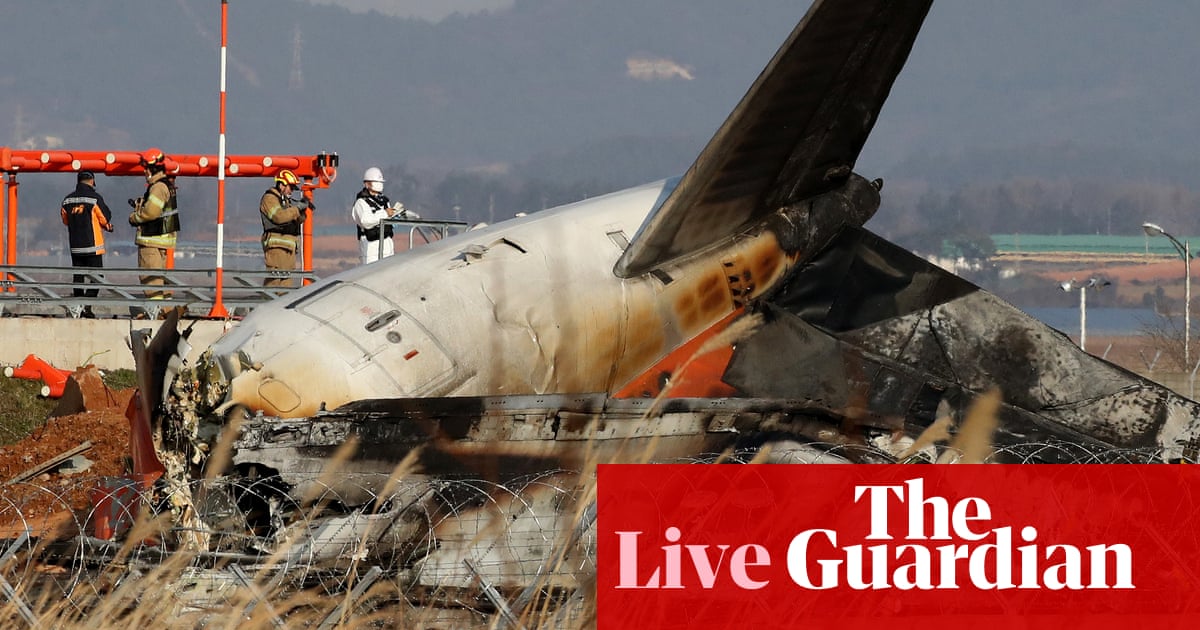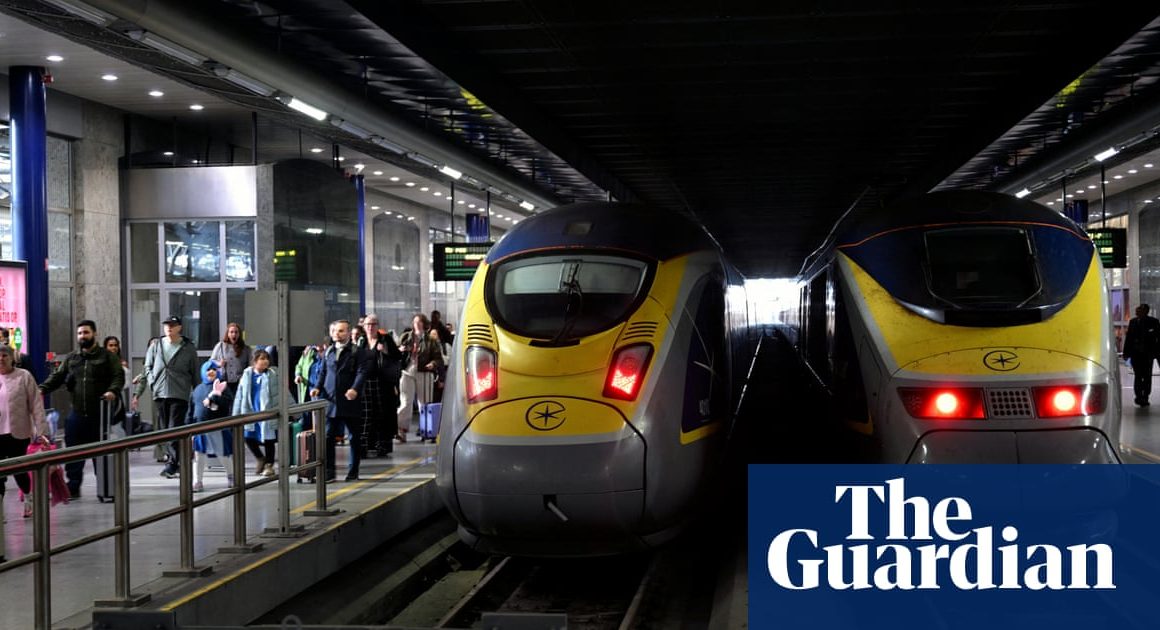Key events
The cause of Sunday’s crash is still unclear. Officials have pointed to a bird strike as a likely reason for the tragedy. A warning of a bird strike was issued by the control tower minutes before the crash.
However, experts who have reviewed footage of the disaster – showing the plane making an emergency landing but then hitting a wall – have questioned whether airport construction could have played a part.
AFP has spoken to Kim Kwang-il, Professor of Aeronautical Science at Silla University and a former pilot, who said there shouldn’t have “a solid structure” in that area at all.
“Normally, at the end of a runway, there’s no such solid obstruction – it’s against international aviation safety standards,” he said.
“The structure in question caused the aircraft to crash and catch fire.
“Outside the airport, there are usually just fences, which are soft and wouldn’t cause significant damage. The plane could have skidded further and stopped naturally. The unnecessary structure is highly regrettable.”
Reuters has spoken to Jeon Je-young, 71, whose daughter Mi-sook was among the 179 people killed in Sunday’s crash.
He keeps playing the video of the disaster, unable to believe what has happened, he says.
“When I saw the accident video, the plane seemed out of control,” said Jeon. “The pilots probably had no choice but to do it. My daughter, who is only in her mid-40s, ended up like this. This is unbelievable.”
Mi-sook was a warm-hearted child, he said. She brought some food and next year’s calendar to his house on 21 December, his last brief moment with her.
Authorities called out the names of some of those killed in the crash on Sunday, triggering an explosion of grief and rage among the passengers’ families gathered in the airport’s arrival area. They screamed, wept and collapsed on the floor of the terminal where their loved ones had been due to return home.
Crime scene investigators have collected saliva swaps from families to run DNA tests to identify the victims.
Jeon’s daughter had been on her way home after travelling with friends to Bangkok for the Christmas holiday. She leaves behind a devastated family, including a husband and teenage daughter.
“The water near the airport is not deep. Here are softer fields than this cement runway. Why couldn’t the pilot land there instead?” Jeon said.
Mi-sook was identified by her fingerprints, and her family is looking for a funeral home near her town of Gwangju to transport her body there.
“She was almost home, so [she saw] no need to call the family [to leave any final message]. She thought she was coming home,” Jeon said.
South Korea reviewing plans for inspection of B737-800 fleet
South Korea is reviewing plans to conduct a “special inspection” of all Boeing 737-800s in operation in the country, following Sunday’s crash, AFP has reported.
“101 B737-800 series aircraft are currently in operation in South Korea. Consequently, we are reviewing plans to conduct a special inspection on B737-800 aircraft,” said Joo Jong-wan, head of the aviation policy bureau at the South Korean transport ministry.
The Jeju Air jet pilot told air traffic control the aircraft had suffered a bird strike and declared mayday shortly before the plane crashed on Sunday, a transport ministry official said on Monday in a media briefing, according to Reuters.
More details to follow.
South Korea’s aviation safety record
As AFP reports, South Korea’s aviation industry has a solid safety record and the crash was the first fatal accident for Jeju Air.
On August 12, 2007, strong winds caused a Jeju Air-operated Bombardier Q400 carrying 74 passengers to veer off the runway at another southern airport, Busan-Gimhae. A dozen people were injured.
Before Sunday, the deadliest plane crash on South Korean soil took place on April 15, 2002, when an Air China Boeing 767 traveling from Beijing hit a hill near Busan-Gimhae, resulting in 129 deaths.
The most recent fatal crash of a South Korean airline happened in San Francisco, California on July 6, 2013. Asiana Airlines’ Boeing 777 aircraft missed its landing, leaving three dead and 182 hurt.
The deadliest disaster to hit a South Korean airline goes back to September 1, 1983, when a Soviet fighter jet shot down a Boeing 747, which Moscow claimed was mistaken for a spy plane.
All 23 crew and 246 passengers aboard the Korean Air flight – a New York-to-Seoul flight via Anchorage, Alaska – were killed.

Emily Wind
I’ll hand the blog over to Rebecca Ratcliffe, who will continue taking you through our rolling coverage. Take care.
Choi orders transport ministry to conduct emergency safety inspection of country’s entire airline system
Circling back to earlier remarks from acting president Choi Sang-mok:
He has also ordered the transport ministry to conduct an emergency safety inspection of the country’s entire airline operation system, Yonhap News Agency reports.
Recovery teams return to site of the crash: photos
Firefighters and recovery teams returned to the site of the crash earlier this morning. Here are some photos that have been filtering through from wire agencies:
140 out of 179 killed in Jeju Air plane crash identified
As Yonhap News Agency reports, the remains of 140 of the 179 people killed in the Jeju Air plane crash have tentatively been identified, according to the land ministry.
During a briefing for victims’ families at Muan International Airport this morning, the ministry said 165 bodies have been moved to a temporary morgue. An official said:
Once we are ready to transfer the bodies following autopsies by investigation agencies, we will contact the families.
The victims’ belongings are being gathered from the runway where the plane belly-landed and crashed into a barrier yesterday, killing 179 of the 181 people onboard.
The site will be preserved pending authorities’ investigation into the cause of the accident.
South Korean government declares seven-day national mourning period
Continuing from our last post, via Yonhap: The South Korean government has declared a seven-day national mourning period until midnight Saturday, amid the crash.
Memorial altars will be established at the crash site and in 17 cities and provinces, including Seoul and the southwestern city of Gwangju. Acting president Choi Sang-mok said:
We hope the public will visit the joint memorial altars to mourn the victims and offer their condolences to the bereaved families.
Choi is leading the centralized disaster control team instead of the prime minister, who would typically be in charge based on a manual prepared after the 2014 sinking of the Sewol ferry, which killed 304 people.
Acting president Choi expresses grief over deadly plane crash
Acting South Korean president Choi Sang-mok has said he is “heartbroken” by the tragic plane crash, acknowledging the additional strain it places on a public already grappling with economic challenges.
As Yonhap News Agency reports, Choi made the remarks while presiding over a disaster control meeting in Seoul. During the meeting he said:
To the honorable citizens of our nation, as an acting president, my heart aches as we face this unforeseen tragedy amid recent economic hardships.
During the meeting Choi, who also serves as deputy prime minister for economic affairs and finance minister, reaffirmed the government’s commitment to deploying all available resources to support the bereaved families and injured survivors.
He further pledged to thoroughly investigate the cause of the accident and promptly disclose the findings to the bereaved families and the public with full transparency.
We will transparently disclose the progress of the investigation into the accident, even before the final results are released, and keep the bereaved families informed.
Jeju Air flight returns after takeoff over similar landing gear issue found in Muan crash
As the Yonhap News Agency reports, a Jeju Air flight that took off in South Korea today has returned to the airport of departure due to the same landing gear issue found in the deadly crash yesterday, according to industry sources.
Jeju Air Flight 7C101, which departed from Gimpo International Airport for Jeju at 6.37am local time, detected an issue with its landing gear shortly after takeoff.
The airline informed the 161 passengers about the mechanical defect caused by the landing gear issue and subsequently returned the flight to Gimpo at 7.25am. Jeju Air plans to resume operations after switching to a replacement aircraft.
Landing gear is an essential device directly related to flight safety, ensuring safe takeoffs and landings while mitigating impact during emergency landings. In Sunday’s Jeju Air crash that claimed 179 lives in the southwestern county of Muan, it is believed that all three landing gears had failed to operate properly.
The aircraft involved in the return flight was a Boeing B737-800, the same model as the one involved in the disaster the previous day. Jeju Air operates 39 of this model out of its fleet of 41 aircraft.
US transportation authorities to assist South Korea’s probe into Jeju Air crash
Yonhap News Agency reports that transportation safety authorities in the United States will help with a probe into the cause of the deadly Jeju Air plane crash.
In an email statement sent to Yonhap, the US Federal Aviation Administration (FAA) said it has formed a team with the National Transportation Safety Board (NTSB) to support South Korean authorities with the investigation.
Donnell Evans, a communications official at the FAA, said:
The NTSB is leading a team of U.S. investigators, that includes the FAA and Boeing, to assist the Republic of Korea’s Aviation and Railway Accident Investigation Board (ARAIB) with their investigation into the Dec. 29 Jeju Air crash.
An official at South Korea’s ARAIB, operated under the country’s transport ministry, said earlier the flight data recorder recovered from the aircraft has been damaged.
If we have difficulty decoding it here, then we may have to send it to the NTSB. They have cases from all over the world to analyze, so it could take quite a bit of time.
More condolences from world leaders
Continuing from our previous post, via AFP: German President Frank-Walter Steinmeier said the crash is “yet another blow to the nation’s heart” after “a difficult period” – alluding to weeks of political turmoil in Seoul.
This is an incredible loss and pain” for the friends and families of those killed.
Tehran expressed its “condolences and sympathy to the government and people of the Republic of Korea and Thailand”, the departure point of the plane which had two Thai nationals on board. Foreign ministry spokesman Esmaeil Baghaei addressed “the families of the victims, and wished a speedy recovery for the injured of this tragic incident”.
Serbian president Aleksandar Vucic wrote on X that “as we watch with disbelief the horrific scenes from the crash site, our thoughts are with the families of those who lost their lives,” adding that he was “deeply shaken”.
Spain’s foreign ministry said that Madrid was “profoundly shocked by the terrible accident”, sending condolences and “all our solidarity” to those affected.
And Turkish president Recep Tayyip Erdogan said in a post on X that “we are deeply saddened by the tragic plane crash that occurred at Muan International Airport in our friend, the Republic of Korea.”
Global condolences flow following deadly air disaster
Condolences are flowing from across the world following South Korea’s deadliest plane crash. As AFP reports, world leaders have expressed their sympathy as relatives of those on board gathered at the airport in grief.
Chinese president Xi Jinping said he was “shocked” to learn of the crash, in a message to South Korea’s acting president Choi Sang-mok. He was quoted by China’s state broadcaster CCTV saying:
I express our deep condolences to the victims, sincere sympathy for the victims’ families, and wish those injured a speedy recovery.
European Commission president Ursula von der Leyen said she was “heartbroken to see images of the plane crash in Muan”.
As your partner, Europe stands with you in this time of grief.
Pope Francis, who visited South Korea a decade ago, told worshippers at the Vatican that he joins “in prayer for the survivors and the dead”.
My thoughts are with the many families in South Korea who are mourning today following the dramatic plane crash.
Welcome summary
Hello and welcome to our coverage of the aftermath of the Jeju Air plane crash in South Korea. My name is Emily Wind, and I’ll be taking you through our rolling updates for the next few hours.
The country is reeling from the loss of 179 people after the plane crash-landed and burst into flames on Sunday morning. A team of US investigators will join local authorities to look at possible causes of the crash.
The Boeing 737-800 was carrying 181 people from Thailand to South Korea when it crashed on arrival Sunday, killing everyone aboard except two flight attendants pulled from the twisted wreckage. It is the worst aviation disaster on South Korean soil.
Officials have cited a bird strike as a likely cause of the crash, which flung passengers from the plane and left it “almost completely destroyed”, according to fire officials. But while families of the dead start to mourn, questions remain over exactly what happened.
Both black boxes – the flight data recorder and the cockpit voice recorder – have been found.
Stay with us as we cover the day’s events.












